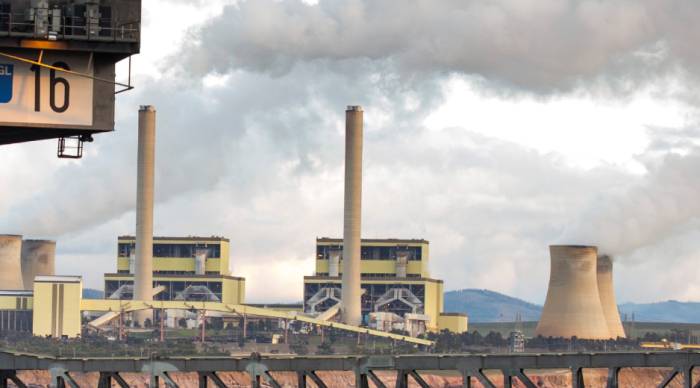
Image: AGL
A troublesome generation unit at the brown coal-fired Loy Yang A power station again experienced problems early yesterday morning – reportedly the sixth incident in just a few weeks.
AGL Loy Yang, which consists of the Loy Yang A power station (four generation units with a combined 2,200MW capacity) and adjacent 800-hectare brown coal mine, generates approximately 15 terawatt-hours of electricity each year. It supplies around 30% of Victoria’s electricity requirements.
Another clunker in Australia’s ageing coal power fleet, Loy Yang A is a source of significant carbon and toxic emissions. Built between 1984 and 1988, the plant and mine won’t be retired until 2048.
Just recently returned to service after planned maintenance resulting from a generator fault in October, SMH reports the latest issue with Unit One occurred late on Tuesday evening and then again at 1.10am on Wednesday morning, “instantly shedding 230 megawatts and 161 megawatts of output respectively.”
The situation has led to a comparison with AGL’s Liddell Power Station, which is to be closed in 2022 and replaced with gas peaker plants, renewable energy, battery storage and demand response.
In a related SMH piece, The Age’s economics editor Peter Martin points out while renewables such as wind and solar power without storage may be intermittent (some prefer the term “variable”), there is some predictability through forecasting. The same can’t be said these days for coal.
“But in summer it’s becoming impossible to know when and where coal-fired power stations will blow. They are becoming unpredictably intermittent, all the more so each year they age,” he said.
Mr. Martin believes the more Australia moves away from coal, the more secure the nation’s electricity system becomes.
The Loy Yang A incident on Tuesday/Wednesday fortunately occurred at a time of low demand. A reduction in output puts extra pressure on other generators; a particularly troublesome situation if it occurs during peak periods on hot days.
A report published by The Australia Institute late last year says extreme heat presents the greatest threat to the security of electricity supply in eastern Australia.
The report recommended there should be a requirement of “heat safe” firming power to act as backup for gas and coal plants. This could include dispatchable solar thermal plants with storage (such as the Aurora project near Port Augusta) and/or additional solar PV capacity to reduce peak demand on hot days, backed by battery storage to provide dispatchable electricity supply into the evenings.
Renewables backed by energy storage have already demonstrated their potential, with Tesla’s “big battery” in South Australia diving in after Loy Yang A 3 tripped without warning last month.
“Even before the Loy Yang A unit had finished tripping, the 100MW/129MWh had responded, injecting 7.3MW into the network to help arrest a slump in frequency that had fallen below 49.80 Hertz,” said RenewEconomy’s Giles Parkinson.

 RSS - Posts
RSS - Posts



How about building a waste burning power plants that they have in Sweden.
Putting a solar panel and vertical wind turbine on all street lights, poles and bridges, all of this would provide power.
Small turbines on creeks and connect waterwheels to add the flow of electricity.
Put battery storage around the country.
Every building having a mix of solar and vertical turbines (chinese lantern style)
So many things we could do if our governments got their heads out of where the sun don’t shine.
Unfortunately (and I say this with heavy heart as a wind enthusiast), the vertical-axis turbines are essentially ornaments at best. They have proponents that claim they are more efficient but this is never borne out by the physics. If it were really true, then the big utility-scale wind farms would be using them all the time – and they are not.
Big turbines work fantastically, unfortunately small ones don’t.
Solar on the other hand scales pretty nicely and we should be able to stick panels and cells over a whole bunch of things.
Hi Scott,
I hope you are wrong but will let you know when we have had ours up for awhile. Fingers crossed.
There is a force that can be relied on regardless of temperature, sunshine, or wind conditions. The tide around the coast of Australia ebbs and flows twice a day 365 days a year, ad infinitum.
From what I can gather tidal range is the stumbling block. Find the solution to this problem and the whole energy supply problem is solved.
I would set a challenge to the students of the engineering department of each university and technical college in Australia to find the solution. Our young people would find it.
Even if the above suggested solutions would be feasible at all, they would require a complete redesign and rebuild of the entire electricity grid, its almost impossible. We must make use if nuclear energy. It provides abundant clean energy. New reactor designs are safe. All we have to do is find a place to store solid waste, its much better than storing it in the atmosphere from burning coal.
If you look at South Australia, you’ll see there’s no need for a grid redesign and rebuild to shut down coal power stations and get 62% of electricity from wind and solar.
Jason,
“We must make use if nuclear energy. It provides abundant clean energy. New reactor designs are safe.”
I’d suggest you look at my questions to James at: https://www.solarquotes.com.au/blog/snowy-2-vs-battery-storage/#comment-1039945
Then read The World Nuclear Industry Status Report 2021 at: https://www.worldnuclearreport.org/World-Nuclear-Industry-Status-Report-2021-773.html